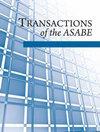Using LiDAR to Measure Alfalfa Canopy Height
IF 1.4
4区 农林科学
Q3 AGRICULTURAL ENGINEERING
引用次数: 0
Abstract
HighlightsModels using LiDAR measurements and field observations as predictors can accurately predict alfalfa canopy height.The most efficient model used only the 95th percentile of LiDAR-measured height to estimate canopy height.Adding field observations of weed, insect, and disease pressure only marginally improved the predictive models.Abstract. Alfalfa is a popular crop that is grown worldwide because it is a nutritious feed for livestock and fixes nitrogen in the soil. Profitable alfalfa production greatly relies on monitoring the status of the alfalfa crop. Traditionally, producers have used crop assessment techniques that rely on manual measurements of alfalfa plant height, which can be used to predict nutritive quality and yield. These manual measurements are often labor-intensive and provide low-resolution data that is not acceptable for field-scale monitoring. The goal of this study was to assess the capability of a simple LiDAR setup to accurately estimate the average canopy height of an alfalfa crop. To achieve this goal, we first developed predictive models of alfalfa canopy height using LiDAR-derived measurements as predictor variables. Second, we assessed the accuracies of the models and compared the properties of each model. Third, we determined the optimal LiDAR-derived measurements to use to accurately predict average alfalfa canopy height. The data used in our models were collected in two separate fields planted with two different cultivars of alfalfa. Data collection was performed on five dates spanning one entire growth cycle during the summer of 2019. A simple single-beam LiDAR sensor was used to scan the canopy of sample plots within the fields. Manual measurements of plant height and field observations of insect, disease, and weed pressure were also recorded. Of the data used in the predictive models, the 95th percentile of LiDAR-measured height was found to be the optimal predictor for estimating alfalfa canopy height. Using the 95th percentile as a single predictor in a linear regression model of measured average canopy height resulted in an R2 of 0.90 and RMSE of 4.5 cm. Two other linear regression models using a combination of LiDAR measurements and LiDAR measurements with alfalfa health observations, respectfully, were developed for comparison. These models exhibited marginally better accuracies but required more inputs than the model only using the 95th percentile. This study shows how simple LiDAR configurations can be used for timely collection of accurate alfalfa canopy height data. From our findings, we suggest using the 95th percentile of LiDAR-derived canopy height to estimate alfalfa canopy height. This study lays the groundwork for research into more advanced LiDAR configurations for alfalfa applications, such as LiDAR-equipped UAVs. Keywords: Alfalfa, Canopy height, LiDAR.利用激光雷达测量紫花苜蓿冠层高度
利用激光雷达测量和实地观测作为预测因子的highlightmodels可以准确地预测紫花苜蓿冠层高度。最有效的模型仅使用激光雷达测量高度的第95百分位来估计冠层高度。加上田间杂草、昆虫和病害压力的观测,对预测模型的改进作用微乎其微。紫花苜蓿是一种在世界各地都很受欢迎的作物,因为它是牲畜的营养饲料,还能固定土壤中的氮。有利可图的苜蓿生产在很大程度上依赖于对苜蓿作物状况的监测。传统上,生产者使用的作物评估技术依赖于人工测量苜蓿株高,这可以用来预测营养质量和产量。这些手动测量通常是劳动密集型的,并且提供的低分辨率数据不适合现场规模的监测。本研究的目的是评估一个简单的激光雷达装置的能力,以准确估计苜蓿作物的平均冠层高度。为了实现这一目标,我们首先利用激光雷达测量数据作为预测变量,建立了苜蓿冠层高度的预测模型。其次,我们评估了模型的准确性,并比较了每个模型的属性。第三,我们确定了用于准确预测紫花苜蓿平均冠层高度的最佳激光雷达衍生测量值。在我们的模型中使用的数据是在种植两种不同苜蓿品种的两个单独的田中收集的。数据收集在2019年夏季的五个日期进行,跨越了整个生长周期。使用简单的单光束激光雷达传感器扫描田野内样地的冠层。还记录了人工测量植物高度和实地观察虫、病和杂草压力。在预测模型中使用的数据中,激光雷达测量高度的第95百分位是估计紫花苜蓿冠层高度的最佳预测因子。在测量的平均冠层高度的线性回归模型中,使用第95百分位作为单一预测因子,R2为0.90,RMSE为4.5 cm。另外两个线性回归模型使用激光雷达测量和激光雷达测量与苜蓿健康观察相结合,分别开发用于比较。这些模型的准确性略好,但需要更多的输入,而不是只使用第95个百分位的模型。本研究展示了如何使用简单的激光雷达配置来及时收集准确的苜蓿冠层高度数据。根据我们的研究结果,我们建议使用激光雷达获得的冠层高度的第95百分位来估计紫花苜蓿的冠层高度。这项研究为研究用于紫花苜蓿应用的更先进的激光雷达配置奠定了基础,例如配备激光雷达的无人机。关键词:紫花苜蓿,冠层高度,激光雷达
本文章由计算机程序翻译,如有差异,请以英文原文为准。
求助全文
约1分钟内获得全文
求助全文
来源期刊

Transactions of the ASABE
AGRICULTURAL ENGINEERING-
CiteScore
2.30
自引率
0.00%
发文量
0
审稿时长
6 months
期刊介绍:
This peer-reviewed journal publishes research that advances the engineering of agricultural, food, and biological systems. Submissions must include original data, analysis or design, or synthesis of existing information; research information for the improvement of education, design, construction, or manufacturing practice; or significant and convincing evidence that confirms and strengthens the findings of others or that revises ideas or challenges accepted theory.
 求助内容:
求助内容: 应助结果提醒方式:
应助结果提醒方式:


